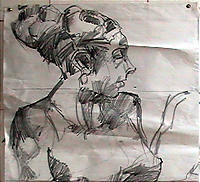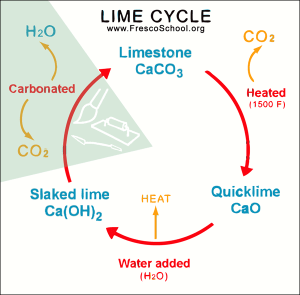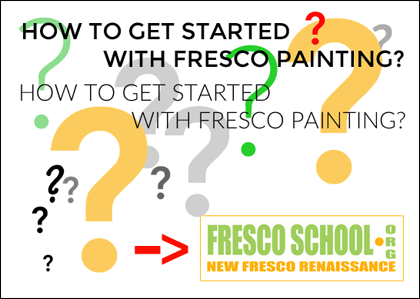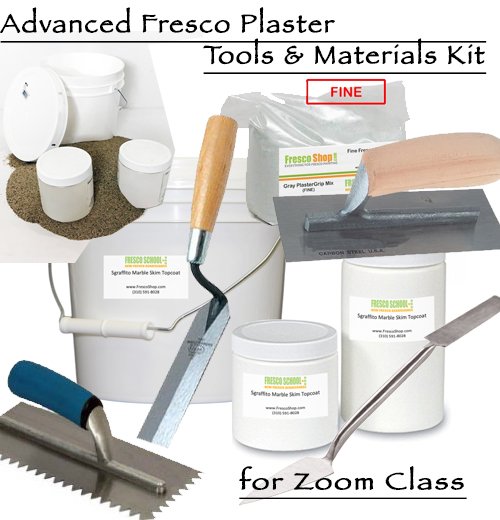- What is Fresco Painting?
- What is Sgraffito Fresco?
- Fresco Glossary of Terms
- River Sand for Fresco Plaster
- Fresco Plaster Coats
- Sgraffito Plaster Coats
- Grinding of Pigments
- Milk of Lime and Limewater
- Historic Fresco Pigments List
- Fresco, Sgraffito Panels
- What is Isolating Primer?
- What is Tadelakt Plaster?
Author: FrescoSchool
Get Started [007]: Degradation and Conservation of Frescoes
 Deterioration of fresco paintings results from the open, porous nature of their support (walls and ceilings of buildings or other carriers) and their interaction with the surrounding micro climates.
Deterioration of fresco paintings results from the open, porous nature of their support (walls and ceilings of buildings or other carriers) and their interaction with the surrounding micro climates.
The porous mortar backing provides an easy route for the movement of dilute salt solutions. Salts contained in the building materials or the surrounding area can be readily transported to the plaster underlying the painting. Old leaky roof, clogged gutters or subterranean walls and/or semi-buried walls – anything that would cause water to soak and remain in the wall will eventually bring salts from adjasent areas into the plaster. The wall and fresco can get wet from the rains and not be affected as long as it is exposed to freely moving air that would dry it naturally.
Expansion in volume associated with crystallization of these salts disrupts the plaster-pigment adhesion and leads to disintegration of the surface. Such crystallization depends on the identity of the salts and the moisture content of masonry which is subject to seasonal variations in atmospheric humidity and the amount of rain.
Continue reading Get Started [007]: Degradation and Conservation of Frescoes
Get Started [006]: Ceramic Tile as the Base for Fresco
Fresco Tile – a work of art and the best learning tool!
Ceramic tile is an amazing learning and practice instrument! This is where you start. With minimum of expense fresco student is able to study the color, form, values using materials available in local masonry stores.
The results are unique to the nature of plaster and even the most simple ones are mesmerizing as they are and even more when framed. Fresco tile is a beautiful stand along art piece it is like a fragment of the wall or ceiling brought up close. From simple color sketch or element study for large fresco to highly realistic portraits or an abstract object is the range of the Fresco Tile.
Examples of the Buon Fresco works on the Ceramic Tiles:
Continue reading Get Started [006]: Ceramic Tile as the Base for Fresco
Get Started [005]: Fresco Cartoon
 Cartoons are drawn on regular paper with pencil, graphite, charcoal, sepia chalk, etc., etc. The purpose of the cartoon is a thorough study and a final rendition of the composition, light, shadow and details of the future fresco. It is a preparatory drawing taken to the next level. Correctly done cartoon is a “stand along” artwork. Although optional in other painting mediums, Cartoon is essential when painting in Fresco not only as the main guideline for the transferring of the design onto freshly laid (fresco) plaster, but also as the main tool and method of understanding and orchestrating the steps for painting of the corresponding fresco.
Cartoons are drawn on regular paper with pencil, graphite, charcoal, sepia chalk, etc., etc. The purpose of the cartoon is a thorough study and a final rendition of the composition, light, shadow and details of the future fresco. It is a preparatory drawing taken to the next level. Correctly done cartoon is a “stand along” artwork. Although optional in other painting mediums, Cartoon is essential when painting in Fresco not only as the main guideline for the transferring of the design onto freshly laid (fresco) plaster, but also as the main tool and method of understanding and orchestrating the steps for painting of the corresponding fresco.
Preparation of the cartoon for the small fresco slightly differs from the preparation of the large fresco cartoon. In this article we discuss the small fresco cartoon. Since this article is intended for the general audience and/or beginner fresco artist it makes sense to illustrate the directions with the actual examples from our fresco workshops. During our workshops artists work from their own cartoons that they have to prepare at home prior to the class. Since many of our students have little or no practical experience in fresco we do not judge nor expect student’s cartoons to be perfect or even fully completed. However it will be helpful to establish some guidelines and explain the reasons behind them.
“Cartoon” – a full scale drawing of the future fresco.
Get Started [004]: Shop Home Depot

Most of the Fresco Plastering Tools are easily found at any local Building Materials store, like Home Depot. Brands will vary but the tools will not. Same tools may have different names, often sales people will not know all the name variations. Just head on to the appropriate isle and look for it yourself.
It is often confusing to find a particular fresco tool or a proper sand at the big building supply store and the store clerks are not familiar with the fresco painting process or materials you need. We have put together a short “iPhone frescoSnaps” video to help you find the right isle as well as to give you an idea of what you can find at the Home Depot that is suitable for fresco.
1 – How to Shop Home Depot for Fresco Painting Materials?
Get Started [003]: Practice Lime Putty.

Build up your fresco plastering skills at the minimum cost!
To gain experience in plastering at a minimal cost it is possible to prepare a “Practice Lime Putty” from common Type-S Hydrated Construction Lime.
Type-S Hydrated Lime is manufactured from Dolomitic Limestone (Dolomitic limestone contains 35 to 46 percent magnesium carbonate).
Being a great lime to practice fresco plaster application techniques, this lime is NOT suitable for the actual painting in fresco due to high content of magnesium which leads to fast setting, poor adhesion/binding of colors and efforescence on the color layer. However, it is widely used in construction (for which it was developed and manufactured: Type-S stands for “Special”) and is available at very low cost almost at any building supplies retailer.
1 – How To Prepare Lime Putty from powdered Type-S Hydrated Constriction Lime?
Get Started [002]: What is Fresco Painting?
 The key to understanding the medium of fresco is the Lime Cycle:
The key to understanding the medium of fresco is the Lime Cycle:
This illustrated guide will outline the main concept of the fresco medium, its process, historical perspective, techniques.
Slaked Lime is mixed with the inert aggregate such as, any and all – sand, crashed marble, pozzolan (tuff – consolidated volcanic ash), etc. General mixing proportion is one (lime) to two (aggregate), however proportions may vary based on style or application. The work must be completed during the formation of the Calcium Carbonate.
1 – The Medium of Fresco – Carbon Based Art for Carbon Based Life
Continue reading Get Started [002]: What is Fresco Painting?
Get Started [001]: Get Organized.
 This guide will answer the question about how to get started with fresco painting in a fast and easy way.
This guide will answer the question about how to get started with fresco painting in a fast and easy way.
First step is to get organized and ready – You will be dealing with fresco plaster, drawing (cartoon), natural and lime stable synthetic pigments selection, fresco paint preparation and actual painting.



